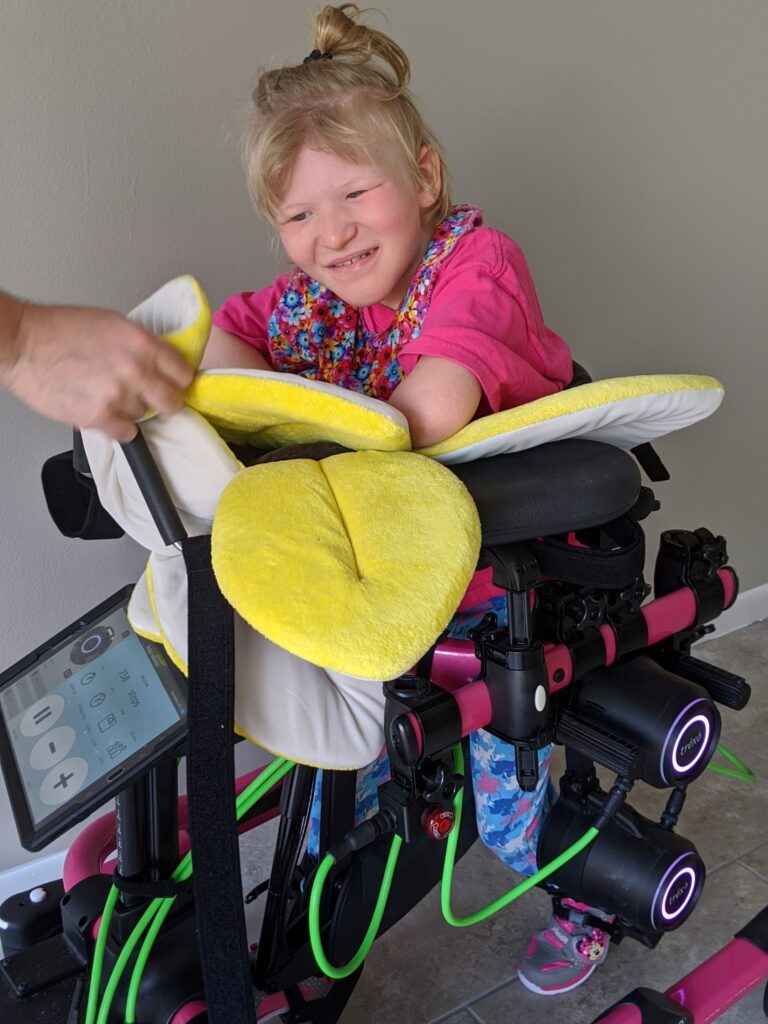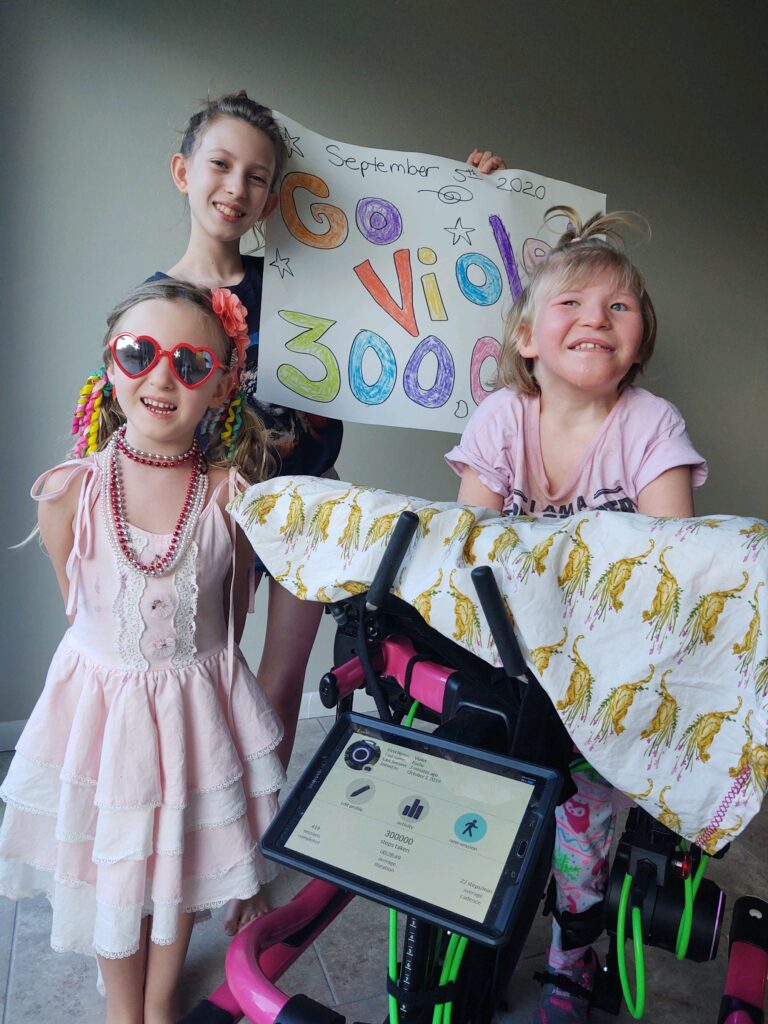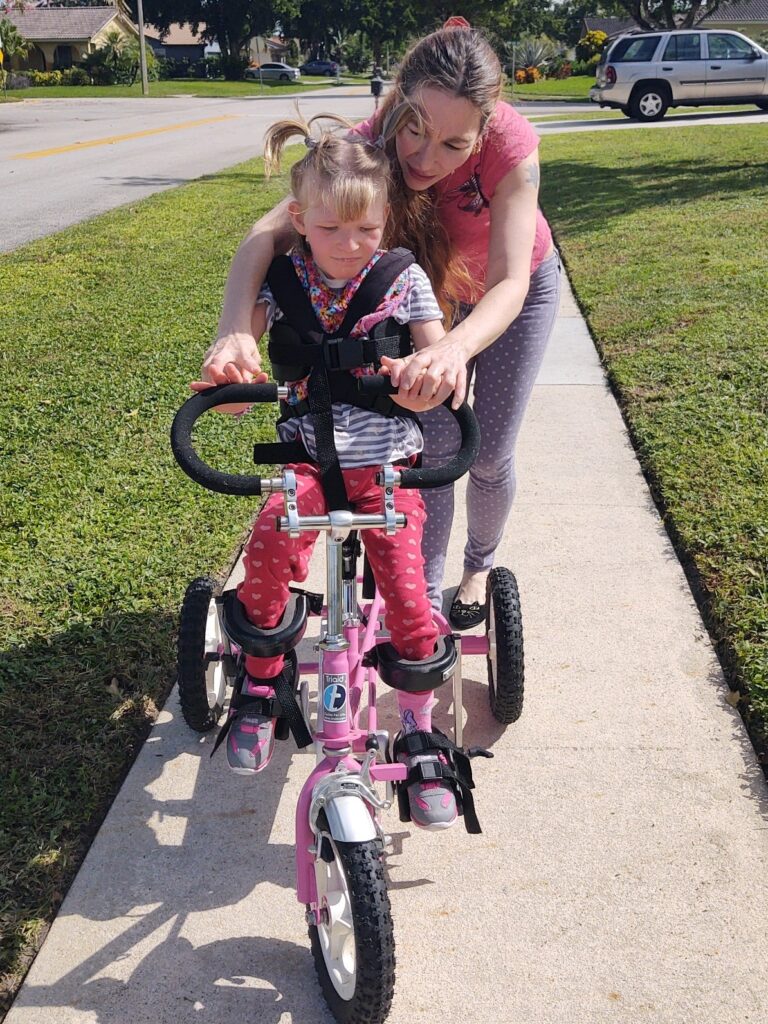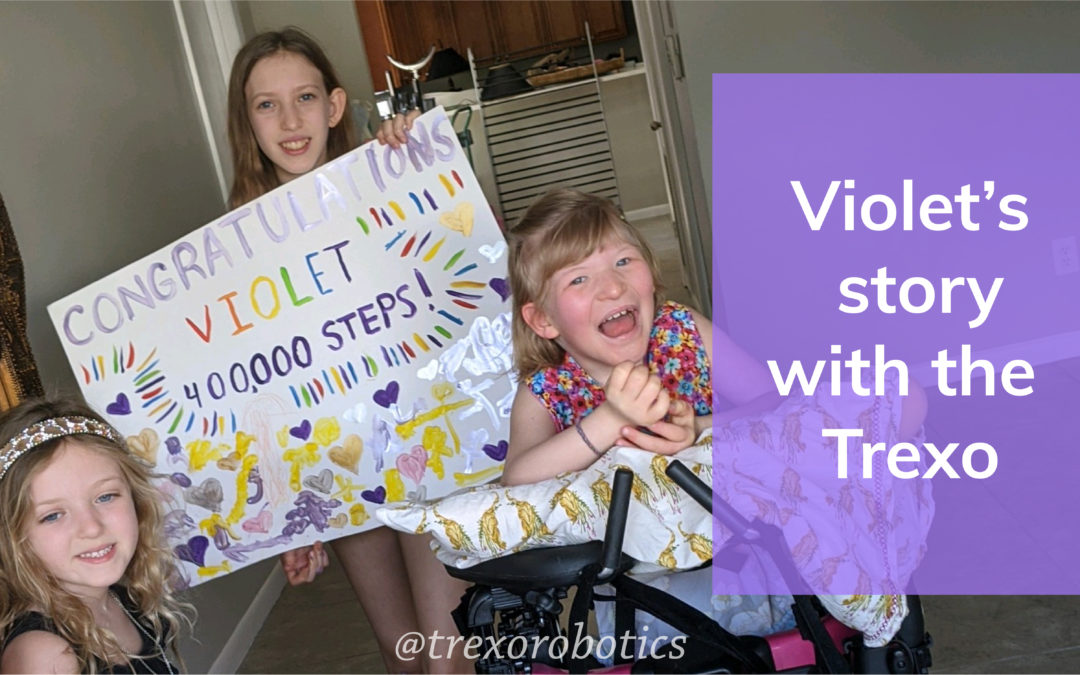This story shares Violet’s experience only. The following is not reflective of results as investigated by a formal research study and reflects the experience of one family
Although Violet wasn’t officially diagnosed until she was 2 years old, her parents, Jen and Tal, knew right away that something was wrong. As Violet grew and received a diagnosis, her parents imagined different types of technologies to help Violet achieve different developmental milestones and found the Trexo.
Violet has now been using the Trexo for over a year and has made huge strides. With consistent practice and an optimistic attitude, Violet has built strength and endurance to walk longer and farther than ever before. Recently, she has started walking with the Trexo without a saddle, a huge milestone showing just how much progress she has made!
Recently, Violet hit a milestone that truly demonstrates just how much strength she has built in her core and legs. She was able to walk in the Trexo without the saddle seat! This is very hard as it requires full weight bearing, ability to stand and keep yourself upright, and weight shift with the rhythm of the steps.
Family fun time with the Trexo for other developmental milestones
Of course, not all benefits that Violet has experienced are directly related to her endurance and strength. Jen and Tal believe in the importance of having your family fully integrated. They teach their kids that neurotypical and neuro-atypical children must function together as one family. This can be hard because you must choose between doing things that everyone is able to participate in.
For Violet’s family, the Trexo is an activity that they can do together as a family. Ruby and Lila see that they can interact with her and cheer her on while she walks in her Trexo. In fact, the Fuchs have shared some amazing videos of Violet crossing several milestones. Like the time she hit 100,000 steps, then 200,000 steps, 300,000 steps and recently 400,000 steps.
Violet has also started to ride her adaptive bike again for the first time since spring. Her first day back on her bike, her head was up 50-75% more than before. She also went longer than she had been able to previously and kept peddling the bike! According to Jen, it was a significant change in her and exciting to see. “We were so happy and so sure it’s due to all her Trexoing” she said as she shared this progress with us.
-

Walking with the Trexo
at home -

Celebrating 300,000 steps with her sisters -

Enjoying a bike ride with her mom’s help
Trexo is a piece of the puzzle
Jen emphasized that the Trexo is not a replacement for other therapies or equipment. They continue to work on therapy to help Violet reach new milestones as related to her areas of developmental delay. Recently, they integrated CBD to help Violet manage pain and help with sleep.
Other challenges have been more difficult to solve, such as helping Violet work on her head control. While many kids who use the Trexo have reported head control improvements, for Violet the challenge is not the same. Due to Violet’s condition, she doesn’t know that her head is down. This is something they continue to work on with Violet’s PT.
All in all, Jen shared how happy they are with the Trexo. Violet was one of the first ten kids to receive the Trexo and has been an avid user since. She also went on to share how much their Trexo evolved with time. “It’s a different machine now than when we first got it”.
Caring for children with special needs like Violet can be physically demanding and hard. But all the little smiles and hugs are worth it.
“We’re super happy to be part of the initial family, happy to grow with you!”
– Jen Fuchs
Looking to find more stories of children using the Trexo? Check out how the Trexo has given freedom to Luz and her family, and then head on and watch the reciprocal motion of Iris’s steps after 6 months of Trexo use.
Curious to try the Trexo? Fill out this form and we will be happy to provide you with more information!
This articles goes in depth on Violet’s progress following 12 months of Trexo use and covers:
- Using the Trexo for regular activity while quarantining at home during COVID-19 and otherwise due to Violet’s compromised immune system
- Building strength and endurance with regular Trexo use
- Developing a stepping pattern response to walk outside of Trexo and ride an adaptive bike
- Using the Trexo for quality family time
Altogether, the Trexo has helped Violet build a lot of self esteem and confidence in her body. Read on to find out how!
Meet Violet
Violet is possibly the most unique human we have ever met. She is very playful, affectionate, has a loving personality and adores being with her sisters Ruby and Lila. She is also the first known person with a MPP5/PALS1 mutation in the world.
Living with a MPP5/PALS1 mutation is a complicated matter. This mutation essentially impairs the global neurological function which can lead to delayed development. As a result, Violet has to learn automatic body responses from swallowing to her vestibular responses, which requires training with lots of consistent repetition. In case you’re not sure, the vestibular system is one of the first to develop and is responsible for helping us manage the relationship between our body, gravity and the physical world.
Through specialty studies, her care team were also able to identify that Violet sees only certain frequencies of light and is cortically blind. Additionally, she has 65% neurological hearing loss. This makes her independent movements and attempts to mobilize very challenging.
When Violet was hospitalized at 2 months of age, the doctors told Violet’s parents that she would not live past age 1. Thinking back to that time, Violet’s mother Jen recalls how frustrating the experience was. No one knew what condition Violet had or how to treat her. But with her parents’ commitment to her health and never taking anything as the final word, Violet is now 8 years old and thriving.
Importance of doing therapy at home
When we asked Jen how they did it, she says it is all about “following your instincts”. She continued to seek answers, even when the doctors couldn’t give a diagnosis and told her not to worry. She also decided to get Violet early intervention so that the lack of a diagnosis would not lead to delay in development.
When Violet was 5, they made the difficult decision to move all her therapy home. Violet’s condition contributes to her immune system being compromised. Each visit to the hospital posed a threat and she was getting sick all the time. As a result, Violet was frequently hospitalized for pneumonia and each hospitalization would cause a set back. This approach simply was not sustainable. Once they stopped visiting hospitals and started getting therapy at home, Violet started making gains.
When COVID-19 hit, Violet’s parents knew right away they had to be extra cautious. While COVID-19 poses danger to everyone’s health, the impact of COVID on immunocompromised children like Violet is much more dangerous. They had to stop home therapy visits in person and limit exposure for the entire family.
With the increasing focus on moving Violet’s therapy home, her parents were dreaming of enabling technologies. For example, they tried the Innowalk but it did not work well for Violet. At the time she was too small for it. They also learned of the NIH trial for crouch gait, but that too was not appropriate for Violet’s developmental level.
Benefits of daily Trexo use
This is why Jen was so excited about the Trexo. Trexo’s versatility and support could be adjusted to meet Violet’s developmental level and help her progress with time. It is also the only robotic equipment that Violet would be able to use at home without the need of external help. Things were looking good!
Over the course of the past year, the Trexo has been integrated into Violet’s routine very firmly. She starts her day with a healthy breakfast and a Trexo session. The goal is to do 1,000 steps every morning. After her jam-packed day of therapies and hanging out with her sisters Ruby and Lila, Violet has another Trexo session for a few hundred more steps.
Noticeable improvements in endurance
When they first received the Trexo, they started with small goals. She could only endure the Trexo for 5-10 minutes at a time. Walking slowly, they first worked up to 100 steps. Eventually they increased both speed and duration to get more steps as Violet got more comfortable with walking. She now claps in excitement when asked if “she wants to go Trexoing” and can walk for up to 2 hours in a single session. On a recent summer morning, Violet took 4,500 steps in one session!
Big developmental milestone: building a stepping response
Violet’s parents noticed many changes in her over the last year that they have been using the Trexo. Jen shared that the Trexo has been “good for her self esteem”. They have also seen a neurological response! Violet’s initiation in the Trexo now hovers in the 40-50% range. This is huge considering she started at 1%!
For neurological illnesses leading to developmental delay such as the one Violet lives with, more repetitions are necessary to build a response. Without the Trexo this would be difficult to achieve. Jen noted that Violet is getting too heavy to carry around. Additionally manual therapy can be incredibly labor intensive and far from perfect. So far, the Trexo has been helping Violet work on her stepping response and reinforce the movement. Violet now can take steps with assistance and move from one room to another in her home.
Stronger legs to walk independently
Recently, Violet hit a milestone that truly demonstrates just how much strength she has built in her core and legs. She was able to walk in the Trexo without the saddle seat! This is very hard as it requires full weight bearing, ability to stand and keep yourself upright, and weight shift with the rhythm of the steps.
Family fun time with the Trexo for other developmental milestones
Of course, not all benefits that Violet has experienced are directly related to her endurance and strength. Jen and Tal believe in the importance of having your family fully integrated. They teach their kids that neurotypical and neuro-atypical children must function together as one family. This can be hard because you must choose between doing things that everyone is able to participate in.
For Violet’s family, the Trexo is an activity that they can do together as a family. Ruby and Lila see that they can interact with her and cheer her on while she walks in her Trexo. In fact, the Fuchs have shared some amazing videos of Violet crossing several milestones. Like the time she hit 100,000 steps, then 200,000 steps, 300,000 steps and recently 400,000 steps.
Violet has also started to ride her adaptive bike again for the first time since spring. Her first day back on her bike, her head was up 50-75% more than before. She also went longer than she had been able to previously and kept peddling the bike! According to Jen, it was a significant change in her and exciting to see. “We were so happy and so sure it’s due to all her Trexoing” she said as she shared this progress with us.
-

Walking with the Trexo
at home -

Celebrating 300,000 steps with her sisters -

Enjoying a bike ride with her mom’s help
Trexo is a piece of the puzzle
Jen emphasized that the Trexo is not a replacement for other therapies or equipment. They continue to work on therapy to help Violet reach new milestones as related to her areas of developmental delay. Recently, they integrated CBD to help Violet manage pain and help with sleep.
Other challenges have been more difficult to solve, such as helping Violet work on her head control. While many kids who use the Trexo have reported head control improvements, for Violet the challenge is not the same. Due to Violet’s condition, she doesn’t know that her head is down. This is something they continue to work on with Violet’s PT.
All in all, Jen shared how happy they are with the Trexo. Violet was one of the first ten kids to receive the Trexo and has been an avid user since. She also went on to share how much their Trexo evolved with time. “It’s a different machine now than when we first got it”.
Caring for children with special needs like Violet can be physically demanding and hard. But all the little smiles and hugs are worth it.
“We’re super happy to be part of the initial family, happy to grow with you!”
– Jen Fuchs
Looking to find more stories of children using the Trexo? Check out how the Trexo has given freedom to Luz and her family, and then head on and watch the reciprocal motion of Iris’s steps after 6 months of Trexo use.
Curious to try the Trexo? Fill out this form and we will be happy to provide you with more information!
This story shares Violet’s experience only. The following is not reflective of results as investigated by a formal research study and reflects the experience of one family.
Overview
This articles goes in depth on Violet’s progress following 12 months of Trexo use and covers:
- Using the Trexo for regular activity while quarantining at home during COVID-19 and otherwise due to Violet’s compromised immune system
- Building strength and endurance with regular Trexo use
- Developing a stepping pattern response to walk outside of Trexo and ride an adaptive bike
- Using the Trexo for quality family time
Altogether, the Trexo has helped Violet build a lot of self esteem and confidence in her body. Read on to find out how!
Meet Violet
Violet is possibly the most unique human we have ever met. She is very playful, affectionate, has a loving personality and adores being with her sisters Ruby and Lila. She is also the first known person with a MPP5/PALS1 mutation in the world.
Living with a MPP5/PALS1 mutation is a complicated matter. This mutation essentially impairs the global neurological function which can lead to delayed development. As a result, Violet has to learn automatic body responses from swallowing to her vestibular responses, which requires training with lots of consistent repetition. In case you’re not sure, the vestibular system is one of the first to develop and is responsible for helping us manage the relationship between our body, gravity and the physical world.
Through specialty studies, her care team were also able to identify that Violet sees only certain frequencies of light and is cortically blind. Additionally, she has 65% neurological hearing loss. This makes her independent movements and attempts to mobilize very challenging.
When Violet was hospitalized at 2 months of age, the doctors told Violet’s parents that she would not live past age 1. Thinking back to that time, Violet’s mother Jen recalls how frustrating the experience was. No one knew what condition Violet had or how to treat her. But with her parents’ commitment to her health and never taking anything as the final word, Violet is now 8 years old and thriving.
Importance of doing therapy at home
When we asked Jen how they did it, she says it is all about “following your instincts”. She continued to seek answers, even when the doctors couldn’t give a diagnosis and told her not to worry. She also decided to get Violet early intervention so that the lack of a diagnosis would not lead to delay in development.
When Violet was 5, they made the difficult decision to move all her therapy home. Violet’s condition contributes to her immune system being compromised. Each visit to the hospital posed a threat and she was getting sick all the time. As a result, Violet was frequently hospitalized for pneumonia and each hospitalization would cause a set back. This approach simply was not sustainable. Once they stopped visiting hospitals and started getting therapy at home, Violet started making gains.
When COVID-19 hit, Violet’s parents knew right away they had to be extra cautious. While COVID-19 poses danger to everyone’s health, the impact of COVID on immunocompromised children like Violet is much more dangerous. They had to stop home therapy visits in person and limit exposure for the entire family.
With the increasing focus on moving Violet’s therapy home, her parents were dreaming of enabling technologies. For example, they tried the Innowalk but it did not work well for Violet. At the time she was too small for it. They also learned of the NIH trial for crouch gait, but that too was not appropriate for Violet’s developmental level.
Benefits of daily Trexo use
This is why Jen was so excited about the Trexo. Trexo’s versatility and support could be adjusted to meet Violet’s developmental level and help her progress with time. It is also the only robotic equipment that Violet would be able to use at home without the need of external help. Things were looking good!
Over the course of the past year, the Trexo has been integrated into Violet’s routine very firmly. She starts her day with a healthy breakfast and a Trexo session. The goal is to do 1,000 steps every morning. After her jam-packed day of therapies and hanging out with her sisters Ruby and Lila, Violet has another Trexo session for a few hundred more steps.
Noticeable improvements in endurance
When they first received the Trexo, they started with small goals. She could only endure the Trexo for 5-10 minutes at a time. Walking slowly, they first worked up to 100 steps. Eventually they increased both speed and duration to get more steps as Violet got more comfortable with walking. She now claps in excitement when asked if “she wants to go Trexoing” and can walk for up to 2 hours in a single session. On a recent summer morning, Violet took 4,500 steps in one session!
Big developmental milestone: building a stepping response
Violet’s parents noticed many changes in her over the last year that they have been using the Trexo. Jen shared that the Trexo has been “good for her self esteem”. They have also seen a neurological response! Violet’s initiation in the Trexo now hovers in the 40-50% range. This is huge considering she started at 1%!
For neurological illnesses leading to developmental delay such as the one Violet lives with, more repetitions are necessary to build a response. Without the Trexo this would be difficult to achieve. Jen noted that Violet is getting too heavy to carry around. Additionally manual therapy can be incredibly labor intensive and far from perfect. So far, the Trexo has been helping Violet work on her stepping response and reinforce the movement. Violet now can take steps with assistance and move from one room to another in her home.
Stronger legs to walk independently
Recently, Violet hit a milestone that truly demonstrates just how much strength she has built in her core and legs. She was able to walk in the Trexo without the saddle seat! This is very hard as it requires full weight bearing, ability to stand and keep yourself upright, and weight shift with the rhythm of the steps.
Family fun time with the Trexo for other developmental milestones
Of course, not all benefits that Violet has experienced are directly related to her endurance and strength. Jen and Tal believe in the importance of having your family fully integrated. They teach their kids that neurotypical and neuro-atypical children must function together as one family. This can be hard because you must choose between doing things that everyone is able to participate in.
For Violet’s family, the Trexo is an activity that they can do together as a family. Ruby and Lila see that they can interact with her and cheer her on while she walks in her Trexo. In fact, the Fuchs have shared some amazing videos of Violet crossing several milestones. Like the time she hit 100,000 steps, then 200,000 steps, 300,000 steps and recently 400,000 steps.
Violet has also started to ride her adaptive bike again for the first time since spring. Her first day back on her bike, her head was up 50-75% more than before. She also went longer than she had been able to previously and kept peddling the bike! According to Jen, it was a significant change in her and exciting to see. “We were so happy and so sure it’s due to all her Trexoing” she said as she shared this progress with us.
-

Walking with the Trexo
at home -

Celebrating 300,000 steps with her sisters -

Enjoying a bike ride with her mom’s help
Trexo is a piece of the puzzle
Jen emphasized that the Trexo is not a replacement for other therapies or equipment. They continue to work on therapy to help Violet reach new milestones as related to her areas of developmental delay. Recently, they integrated CBD to help Violet manage pain and help with sleep.
Other challenges have been more difficult to solve, such as helping Violet work on her head control. While many kids who use the Trexo have reported head control improvements, for Violet the challenge is not the same. Due to Violet’s condition, she doesn’t know that her head is down. This is something they continue to work on with Violet’s PT.
All in all, Jen shared how happy they are with the Trexo. Violet was one of the first ten kids to receive the Trexo and has been an avid user since. She also went on to share how much their Trexo evolved with time. “It’s a different machine now than when we first got it”.
Caring for children with special needs like Violet can be physically demanding and hard. But all the little smiles and hugs are worth it.
“We’re super happy to be part of the initial family, happy to grow with you!”
– Jen Fuchs
Looking to find more stories of children using the Trexo? Check out how the Trexo has given freedom to Luz and her family, and then head on and watch the reciprocal motion of Iris’s steps after 6 months of Trexo use.
Curious to try the Trexo? Fill out this form and we will be happy to provide you with more information!


Recent Comments